Logroño
Logroño (UK: /lɒˈɡrɒnjoʊ/, US: /ləˈɡroʊnjoʊ, loʊˈ-/,[2][3][4] Spanish: [loˈɣɾoɲo] (![]()
Logroño | |
|---|---|
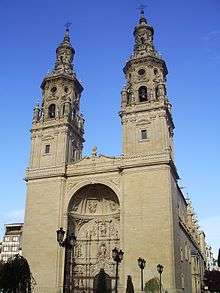 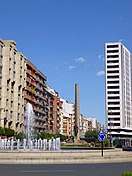 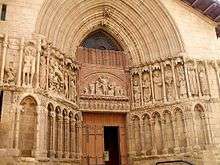   | |
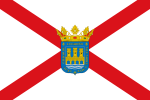 Flag  Coat of arms | |
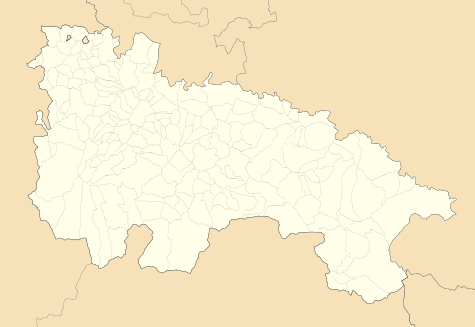 Logroño Location of Logroño within La Rioja  Logroño Logroño (Spain) | |
| Coordinates: 42°27′54″N 2°26′44″W | |
| Country | |
| Autonomous community | |
| Comarca | Rioja Media |
| Government | |
| • Mayor | Pablo Hermoso de Mendoza (PSOE) |
| Area | |
| • Municipality | 79.57 km2 (30.72 sq mi) |
| Elevation | 384 m (1,260 ft) |
| Population (2018)[1] | |
| • Municipality | 151,113 |
| • Density | 1,900/km2 (4,900/sq mi) |
| • Metro | 197,000 |
| Time zone | UTC+1 (CET) |
| • Summer (DST) | UTC+2 (CEST) |
| Website | www |
| 336 km (209 mi) to Madrid; Fuero given in 1095 | |
The population of the city in 2008 was 153,736 while the metropolitan area included nearly 197,000 inhabitants. The city is a centre of the trade in Rioja wine, for which the area is noted, and produces wood, metal and textile products.
Etymology
Origin of the name
The origin of this toponym is, as for many other places, unknown. The name Lucronio was first used in a document from 965 where García Sánchez I of Pamplona donated the so-called place to the Monastery of San Millán. In the fuero from 1095 it appeared under the name Logronio, except once when it was called illo Gronio. The most broadly accepted theses seem to be those which indicate it is a late latinization by prefixing the article "lo/illo" to the old toponym Gronio/Gronno,[5] a word of Celtic origin which means the ford or the pass. It is believed that this name was due to the frequent use of this place to cross the Ebro river.
Other historians have proposed alternative theories, such as a possible derivation from Lucus Brun or Lucus Beronius ("Sacred place in the Beronian forest"), but its etymology remains unknown.[6]
Titles
John II of Castile granted it the title of "City" on 7 February 1431 in Palencia and ratified it on 20 February in Valladolid,[7] thus it stopped being called "Village", despite there being no explicit justification of the reasons for that change. 20 July 1444 the same king added the titles of "Very noble", Spanish: Muy Noble, and "Very loyal", Spanish: Muy Leal, which up until today appear in the seal of the city. In this case, the reason was the loyalty of the habitants against the homonymous king John II of Aragon, because despite the «long war, and wounds and deaths, and robberies, and fires, and damages and oppresions», the city remained loyal to the service of the king of Castile.
5 July 1523, the king Charles I granted it the three fleurs-de-lis for the shield of the city for its resistance during the French siege in 1521.
It also received by Royal Decree the title of "Excellence" 6 December 1854 from Isabella II, as a reward for its behavior during the cholera epidemic which devastated the city.
Geography
Logroño is located in the northern region of La Rioja, on the river Ebro, 384 metres (1,260 feet) above sea level. The Camino de Santiago passes through the city. The geographical coordinates of the city are: 42° 27′ N, 2° 29′ W.
The city lies 152 km (94 mi) from Bilbao, 172 km (107 mi) from Zaragoza, 336 km (209 mi) from Madrid and 468 km (291 mi) from Barcelona.
History
_in_Logro%C3%B1o.jpg)
Logroño was an old settlement, first of the Romans, under the name of Vareia,[8] a commercial port, and then of the Celts. From the 10th century, possession of Logroño was disputed between the kings of Navarre and those of Castile; the region was finally annexed to Castile. The name is a combination of le and Groin, mashed together as Logroño over time. Alfonso VI of Castile granted Logroño in 1095 a charter of rights that served as a model for other Spanish cities. In 1609 and 1610 Logroño was the main seat of the Basque witch trials, part of the Spanish Inquisition.
Famous people from Logroño include Manuel Bretón de los Herreros, Fausto Elhúyar, Práxedes Mateo Sagasta, Rafael Azcona, Ramón Castroviejo, Pedro J. Ramírez, Navarrete "El Mudo".
Demographics
Population centres
- Logroño
- El Cortijo
- Varea
Politics
| Term | Name of Mayor | Political Party |
|---|---|---|
| 1979–1983 | Miguel Ángel Marín | UCD |
| 1983–1987 | Manuel Sainz Ochoa | PSOE |
| 1987–1991 | Manuel Sainz Ochoa | PSOE |
| 1991–1995 | Manuel Sainz Ochoa | PSOE |
| 1995–1999 | José Luis Bermejo | PP |
| 1999–2003 | Julio Revuelta | PP |
| 2003–2007 | Julio Revuelta | PP |
| 2007–2011 | Tomás Santos | PSOE |
| 2011–2015 | Cuca Gamarra | PP |
| 2015–2019 | Cuca Gamarra | PP |
| 2019– | Pablo Hermoso de Mendoza | PSOE |
Economy
Logroño is the shopping and financial capital of La Rioja. Its economy is heavily reliant on wine. It is twinned with Dunfermline, Darmstadt, Libourne, Dax, Rancagua, Ciudad de La Rioja, Brescia, El Hagounia. The new airport Logroño-Agoncillo connects the city with Madrid.
Food
There are over 50 taperías (tapas restaurants) located within a four-block area near the town center. The traditional tapas restaurants often serve only one tapa [such as seta (mushroom), served as pincho – pintxo in Basque – meaning one serving, or media ración ("half portion"), a small plate of tapas, but offer the Rioja D.O..
Climate
The weather in Logroño – mostly due to its peculiar location, both in terms of distance to the Atlantic coast and in the situation along the course of the Ebro river, is characterized by values ranging from those typically found in temperate oceanic climates to the warmer and drier ones observed in southeastern mediterranean regions of the river's valley. The average annual temperature is 13.9 °C (57 °F).[9][10] Although much infrequent, unusually low temperatures during the winter can drop to −5 °C (23 °F), and as low as −10 °C (14 °F); while daily high averages may exceptionally exceed the mark of 35 °C (95 °F) in a particularly hot summer. The average annual precipitation is about 400 mm (15.75 in), regularly spread over the whole year: from 20 mm (0.79 in)–25 mm (0.98 in) in drier periods to the 45 mm (1.77 in)-50 mm (1.97 in) range in the rainiest.[10]
| Climate data for Logroño | |||||||||||||
|---|---|---|---|---|---|---|---|---|---|---|---|---|---|
| Month | Jan | Feb | Mar | Apr | May | Jun | Jul | Aug | Sep | Oct | Nov | Dec | Year |
| Record high °C (°F) | 19.3 (66.7) |
23.0 (73.4) |
27.6 (81.7) |
31.2 (88.2) |
37.6 (99.7) |
42.2 (108.0) |
42.8 (109.0) |
40.6 (105.1) |
39.0 (102.2) |
31.4 (88.5) |
27.4 (81.3) |
21.4 (70.5) |
42.8 (109.0) |
| Average high °C (°F) | 9.9 (49.8) |
12.0 (53.6) |
15.9 (60.6) |
17.8 (64.0) |
22.0 (71.6) |
26.9 (80.4) |
30.1 (86.2) |
29.8 (85.6) |
25.8 (78.4) |
20.1 (68.2) |
13.8 (56.8) |
10.2 (50.4) |
19.5 (67.1) |
| Daily mean °C (°F) | 5.9 (42.6) |
7.2 (45.0) |
10.2 (50.4) |
12.0 (53.6) |
15.9 (60.6) |
20.1 (68.2) |
22.8 (73.0) |
22.7 (72.9) |
19.3 (66.7) |
14.7 (58.5) |
9.5 (49.1) |
6.5 (43.7) |
13.9 (57.0) |
| Average low °C (°F) | 2.0 (35.6) |
2.4 (36.3) |
4.6 (40.3) |
6.3 (43.3) |
9.7 (49.5) |
13.3 (55.9) |
15.6 (60.1) |
15.6 (60.1) |
12.9 (55.2) |
9.2 (48.6) |
5.3 (41.5) |
2.8 (37.0) |
8.3 (46.9) |
| Record low °C (°F) | −11.6 (11.1) |
−9.6 (14.7) |
−8.8 (16.2) |
−3.6 (25.5) |
0.6 (33.1) |
4.8 (40.6) |
7.2 (45.0) |
6.2 (43.2) |
3.0 (37.4) |
−1.2 (29.8) |
−8.2 (17.2) |
−11.6 (11.1) |
−11.6 (11.1) |
| Average precipitation mm (inches) | 28 (1.1) |
23 (0.9) |
26 (1.0) |
46 (1.8) |
47 (1.9) |
44 (1.7) |
30 (1.2) |
21 (0.8) |
26 (1.0) |
37 (1.5) |
40 (1.6) |
38 (1.5) |
405 (15.9) |
| Average relative humidity (%) | 78 | 72 | 65 | 64 | 62 | 57 | 55 | 58 | 64 | 72 | 77 | 80 | 67 |
| Mean monthly sunshine hours | 105 | 133 | 189 | 198 | 225 | 270 | 312 | 285 | 220 | 164 | 113 | 93 | 2,305 |
| Source: AEMET[10][11] | |||||||||||||
Places of interest
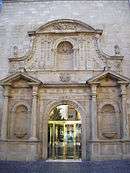
- Con-Catedral de Santa María de la Redonda
- Iglesia (Church) de San Bartolomé
- Iglesia de Santiago
- Iglesia de Palacio
- Museo de La Rioja
- Parlamento de La Rioja, an old factory of the tabacalera, the national tobacco company.
- Muralla del Revellín
- Fuente (Fountain) de los Riojanos Ilustres, in which royal figures with a connection to either Logroño or La Rioja are represented in bronze. Because the figures are placed looking towards the public and so large torrents of water pour down behind them, the fountain is commonly known as the one with "wet backs".
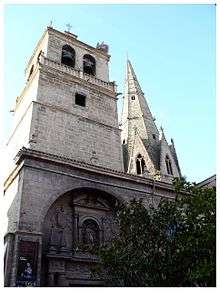
- Bridge of Mantible, in the El Cortijo district. Constructed during the Roman era and declared Bien de Interés Cultural in the Monument category on January 25, 1983.
- Theatre of Bretón de los Herreros
Recreation (plazas and parks)
- Paseo del Príncipe de Vergara (El Espolón): Located in the financial center of the capital and positioned in the center by the statue of General Espartero.
- Plaza del Ayuntamiento: Located on the Avenue of Peace, the modern Town Hall of Logroño, designed by architect Rafael Moneo, is in a large plaza where in years past it has seen numerous public acts, festivals, expositions, concerts, and in the last few years, during Christmas, a life size reconstruction of the nativity scene.
- Parque del Carmen: Located near the bus station, this park has a variety of flora and fauna including several ducks and birds.
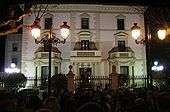
- Plaza del Mercado: Located somewhere near Calle Portales, one of the most famous avenues of the city, at the foot of the Round Cathedral. This is where the nightly festivals of Logroño occur, near Calle Mayor (Marqués de San Nicolas Street).
- Parque del Ebro: Located near the Ebro, an extensive park full of vegetation ideal for relaxing. Also has a bike path traversing through the park.
- Parque de la Ribera: Next to Parque del Ebro, recently constructed. Here many gardens are found alongside the Plaza de Toros de la Ribera. Also: Riojaforum. Palacio de Congresos y Auditorio de La Rioja
- Parque de San Miguel
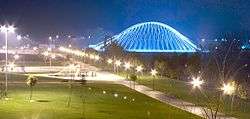
Social life
Calle del Laurel, known as "the path of the elephants" and Calle San Juan are typical streets where various restaurants and tapas bars offer some of the best pinchos and tapas in northern Spain. Calle Portales is the main street in the old town, where people like to walk and sit in the terraces to eat a meal or drink wine. Calle Marqués de San Nicolás (otherwise known as Calle Mayor) is the main area where people spend weekend nights.
Broadcasting stations
Southwest of Logroño, at 42°26'34"N 2°30'43"W, there is a mediumwave broadcasting station with a transmission power of 20 kW. There may exist a longwave transmitter with 300 metres tall masts at Logroño with 300 metres tall masts transmitting RNE Todo Noticias on 207 kHz.
Sports
- CB Ciudad de Logroño - handball-Liga ASOBAL - CB Ciudad de Logroño
- Club Voleibol Logroño - volleyball-Superliga Femenina - Club Voleibol Logroño
- EdF Logroño - women's football-Primera División - EdF Logroño
- UD Logroñés - football-Segunda División B - UD Logroñés
- SD Logroñés - football-Segunda División B - SD Logroñés
- Yagüe CF - football-Tercera División
Triple jumper Carlota Castrejana is from the city. David Lopez Moreno, the Brighton & Hove Albion midfielder is from Logroño.
Festivals and traditions
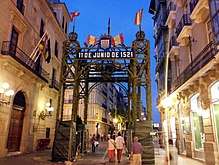
The patron saint of Logroño is Santa María de la Esperanza.
The most important festivals are:
- San Bernabé (Saint Barnabas), celebrated on June 11, commemorating the victory and resistance of Logroño against French invaders under Francis I that besieged the city in May and June 1521. During this celebration, fried trout is typically served by the Fish Brotherhood, along with bread and wine, allegedly the only foodstuffs available in Logroño during the siege.
- San Mateo, celebrated between September 20 and September 26. Since 2006 the celebrations start the Saturday before September 21 (the day of Saint Matthew) and last for a week.
During the first week of January there is a cultural festival known as "ACTUAL" with music, theater and art.
International relations
Twin towns and sister cities
Logroño is twinned with:



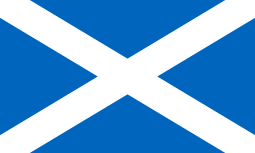
- El Hagounia, Western Sahara (since 1991)[15]



Logroño is associated with:


Transport
The city is served by the Logroño railway station.
In popular culture
In the 4th season of the HBO television series True Blood, the witch Antonia is from Logroño. She refers to herself as Antonia Galván de Logroño.
Notable people
Some notable people from Logroño are:
- Juan Fernández de Navarrete, (1526-1579), Mannerist painter.
- Rodrigo de Arriaga, (1592-1667) philosopher, theologian and Jesuit.
- Fausto Elhuyar, (1755-1833) and Juan José Elhuyar (1754-1796) chemists and discoverers of tungsten.
- Martín Zurbano, (1788-1845) liberal military figure.
- Baldomero Espartero, (1793-1879) general and liberal politician.
- Cosme García Sáez, (1818-1874) engineer, first to invent a submersible.
- Ildefonso Zubía, (1819-1891) pharmacist and botanist.
- Julio Rey Pastor, (1888-1962) mathematician.
- María Teresa León, (1903-1988) writer of the Generation of '27.
- Ramón Castroviejo, (1904-1987) eye surgeon.
- María Teresa Gil de Gárate, (1906-1985) educator.
- Gerardo Sacristán, (1907-1964) painter.
- Pepe Blanco, (1911-1981) singer and actor.
- Enrique Blanco Lac, (1914-1994) painter.
- Manuel Jalón, (1925-2011) engineer and inventor.
- Rafael Azcona, (1926-2008) screenwriter and novelist.
- Soledad Bravo, (1943-) Venezuelan singer of Spanish origin.
- Jesús Vicente Aguirre, (1948-) singer-songwriter and writer.
- Pedro J. Ramírez, (1952-) journalist and editor of El Español.
- Luis Burgos, (1957-) representational painter.
- Gaspar Llamazares, (1957-) doctor and politician of Izquierda Abierta.
- Angela Muro, (1962-) actress, singer and componist.
- Pepe Viyuela, (1963-) actor and comedian.
- Eduardo Sáenz de Cabezón, (1972-) mathematician and science communicator.
- Pablo Sainz Villegas, (1977-) classical guitarist.
- Daniel Aranzubía, (1979-) former football player.
- Carlos Coloma Nicolás, (1981-) cross-country mountain biker.
- Pau Quemada, (1983-) field hockey player.
- Alberto Garzón, (1985-) economist and politician of United Left.*
Gallery
 Roman ruins in Varea, near Logroño. This old village was known as "Vareia".
Roman ruins in Varea, near Logroño. This old village was known as "Vareia". Monumento del Fuero de Logroño, given by Alfonso VI in 1095, near the Town Hall
Monumento del Fuero de Logroño, given by Alfonso VI in 1095, near the Town Hall Arch of Revellín Wall
Arch of Revellín Wall- Science "House"
_of_Universidad_de_La_Rioja_in_Logro%C3%B1o.jpg) Universidad de La Rioja
Universidad de La Rioja
References
- Municipal Register of Spain 2018. National Statistics Institute.
- "Logroño". Collins English Dictionary. HarperCollins. Retrieved March 2, 2019.
- "Logroño" (US) and "Logroño". Oxford Dictionaries UK Dictionary. Oxford University Press. Retrieved March 2, 2019.
- "Logroño". Merriam-Webster Dictionary. Retrieved July 30, 2019.
- I. Rodríguez y R. de Lama, Colección diplomática medieval de La Rioja, vol. I, Logroño 1979, 272-293
- Urbano Espinosa (1993). "El gentilicio Berones en el topónimo Logroño". In Jürgen Untermann; Jaime Siles (eds.). Studia palaeohispanica et indogermanica J. Untermann ab amicis hispanicis oblata. Edicions Universitat Barcelona. p. 139. ISBN 978-84-475-0418-3.
El gentilicio Berones en el topónimo Logroño Urbano Espinosa Logroño forma parte de un reducido grupo de topónimos mayores en la España septentrional. cuya etimología resulta inexplicable.
- Rolled leather parchment sealed with lead and the royal seal. Valladolid, 20 February 1431. Logroño municipal register
- Keay, S.; R. Mathisen; H. Sivan; R. Talbert; T. Elliott; S. Gillies. "Places: 246729 (Vareia?)". Pleiades. Retrieved August 27, 2013.
- "Weather in Logroño". Archived from the original on 1 May 2013. Retrieved 12 June 2012.
- "Standard Climate Values for Logroño". Agencia Estatal de Meteorología. Retrieved 5 June 2015.
- "Extreme Climate Values for Logroño". Agencia Estatal de Meteorología. Retrieved 5 June 2015.
- "Städtepartnerschaften und Internationales". Büro für Städtepartnerschaften und internationale Beziehungen (in German). Archived from the original on 2013-07-23. Retrieved 2013-07-26.
- Rioja, La. "Actos del 50 Aniversario del hermanamiento entre Dax y Logroño - laRioja.com. Foto 1 de 38". www.larioja.com.
- A-Z Twinning and Networking (. Accessed 2010-11-02.)
- "Ayuntamiento de Logroño | Hagunia" (in Spanish). Xn--logroo-0wa.es. Retrieved 2018-05-11.
- "Ayuntamiento de Logroño | Libourne" (in Spanish). Xn--logroo-0wa.es. Retrieved 2018-05-11.
- "Ayuntamiento de Logroño | Rancagua" (in Spanish). Xn--logroo-0wa.es. Retrieved 2018-05-11.
- "National Commission for Decentralised cooperation". Délégation pour l’Action Extérieure des Collectivités Territoriales (Ministère des Affaires étrangères) (in French). Archived from the original on 2013-10-04. Retrieved 2013-12-26.
External links
| Wikivoyage has a travel guide for Logroño. |
- Official website (in Spanish)
- University of La Rioja (in Spanish)
- Bermemar (in Spanish)
- Mayors of Logroño (in Spanish)
- Fish Brotherhood (in Spanish)
| Wikimedia Commons has media related to Logroño. |